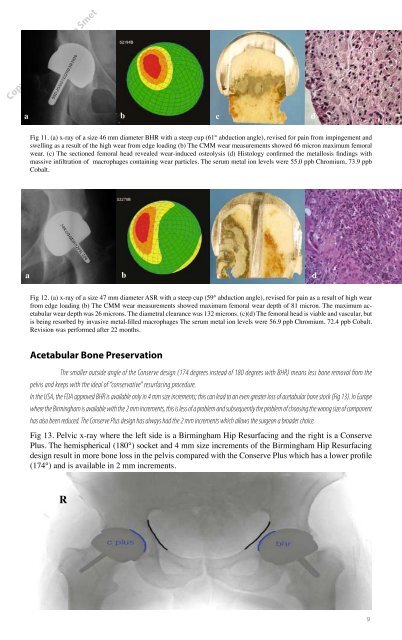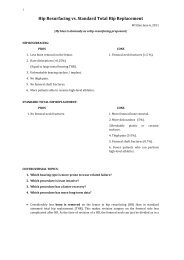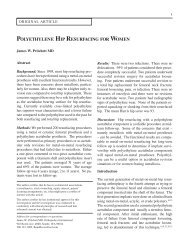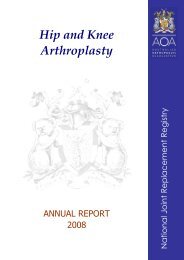Birmingham H ip Resurfacing v ersus C onserv e Plus M etal-on-M ...
Birmingham H ip Resurfacing v ersus C onserv e Plus M etal-on-M ...
Birmingham H ip Resurfacing v ersus C onserv e Plus M etal-on-M ...
Create successful ePaper yourself
Turn your PDF publications into a flip-book with our unique Google optimized e-Paper software.
Copyright Dr. Koen De Smet<br />
a b c d<br />
Fig 11. (a) x-ray of a size 46 mm diameter BHR with a steep cup (61° abducti<strong>on</strong> angle), revised for pain from impingement and<br />
swelling as a result of the high wear from edge loading (b) The CMM wear measurements showed 66 micr<strong>on</strong> maximum femoral<br />
wear. (c) The secti<strong>on</strong>ed femoral head revealed wear-induced osteolysis (d) Histology c<strong>on</strong>firmed the m<str<strong>on</strong>g>etal</str<strong>on</strong>g>losis findings with<br />
massive infiltrati<strong>on</strong> of macrophages c<strong>on</strong>taining wear particles. The serum m<str<strong>on</strong>g>etal</str<strong>on</strong>g> i<strong>on</strong> levels were 55.0 ppb Chromium, 73.9 ppb<br />
Cobalt.<br />
a b c d<br />
Fig 12. (a) x-ray of a size 47 mm diameter ASR with a steep cup (59° abducti<strong>on</strong> angle), revised for pain as a result of high wear<br />
from edge loading (b) The CMM wear measurements showed maximum femoral wear depth of 81 micr<strong>on</strong>. The maximum acetabular<br />
wear depth was 26 micr<strong>on</strong>s. The diametral clearance was 132 micr<strong>on</strong>s. (c)(d) The femoral head is viable and vascular, but<br />
is being resorbed by invasive m<str<strong>on</strong>g>etal</str<strong>on</strong>g>-filled macrophages The serum m<str<strong>on</strong>g>etal</str<strong>on</strong>g> i<strong>on</strong> levels were 56.9 ppb Chromium, 72.4 ppb Cobalt.<br />
Revisi<strong>on</strong> was performed after 22 m<strong>on</strong>ths.<br />
Acetabular B<strong>on</strong>e Preservati<strong>on</strong><br />
The smaller outside angle of the C<str<strong>on</strong>g><strong>on</strong>serv</str<strong>on</strong>g>e design (174 degrees instead of 180 degrees with BHR) means less b<strong>on</strong>e removal from the<br />
pelvis and keeps with the ideal of “c<str<strong>on</strong>g><strong>on</strong>serv</str<strong>on</strong>g>ative” resurfacing procedure.<br />
In the USA, the FDA approved BHR is available <strong>on</strong>ly in 4 mm size increments; this can lead to an even greater loss of acetabular b<strong>on</strong>e stock (Fig 13). In Europe<br />
where the <str<strong>on</strong>g>Birmingham</str<strong>on</strong>g> is available with the 2 mm increments, this is less of a problem and subsequently the problem of choosing the wr<strong>on</strong>g size of comp<strong>on</strong>ent<br />
has also been reduced. The C<str<strong>on</strong>g><strong>on</strong>serv</str<strong>on</strong>g>e <str<strong>on</strong>g>Plus</str<strong>on</strong>g> design has always had the 2 mm increments which allows the surge<strong>on</strong> a broader choice.<br />
Fig 13. Pelvic x-ray where the left side is a <str<strong>on</strong>g>Birmingham</str<strong>on</strong>g> H<str<strong>on</strong>g>ip</str<strong>on</strong>g> <str<strong>on</strong>g>Resurfacing</str<strong>on</strong>g> and the right is a C<str<strong>on</strong>g><strong>on</strong>serv</str<strong>on</strong>g>e<br />
<str<strong>on</strong>g>Plus</str<strong>on</strong>g>. The hemispherical (180°) socket and 4 mm size increments of the <str<strong>on</strong>g>Birmingham</str<strong>on</strong>g> H<str<strong>on</strong>g>ip</str<strong>on</strong>g> <str<strong>on</strong>g>Resurfacing</str<strong>on</strong>g><br />
design result in more b<strong>on</strong>e loss in the pelvis compared with the C<str<strong>on</strong>g><strong>on</strong>serv</str<strong>on</strong>g>e <str<strong>on</strong>g>Plus</str<strong>on</strong>g> which has a lower profile<br />
(174°) and is available in 2 mm increments.<br />
R<br />
9






